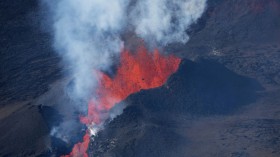DSCOVR or Deep Space Climate Observatory, the first space weather satellite of the National Oceanic and Atmospheric Administration (NOAA), will start monitoring weather storms in space starting July 27. With improved technology, it can provide forecasters with information that will allow them to issue more accurate and timely geomagnetic storm warnings.
"It's all systems go for #DSCOVR, @NOAA's new space weather observing system," NOAA tweeted on June 23.
It’s all systems go for #DSCOVR, @NOAA’s new space weather observing system. @NWSSWPC https://t.co/YQBLck2n2E pic.twitter.com/p2LTomijQZ — NOAA (@NOAA) June 23, 2016
The announcement came following the completion of the satellite's instrument validation. DSCOVR is equipped with a Faraday Cup plasma sensor for measuring the temperature, speed and density of solar wind. It also has a magnetometer for measuring the direction and strength of the solar wind magnetic field. A camera and a radiometer are among its other instruments, according to SpaceFlight Now. DSCOVR has better equipment than its predecessor, NASA's ACE or Advanced Composition Explorer. NOAA describes this new satellite as something like a "distant early-warning sentinel" that would inform them of eruptions from the sun.
"Even though the sun is 93 million miles away, activity on the surface of the sun can have significant impacts here on Earth," said Tom Berger, director of NOAA's Space Weather Prediction Center.
They can then issue a warning up to an hour before Earth is hit with a surge of magnetic field and particles, so the general public, businesses and organizations can take necessary measures to protect any vulnerable equipment.
"Severe space weather can disrupt power grids, marine and aviation navigation, satellite operations, GPS systems and communication technologies," Berger said. "DSCOVR will allow us to deliver more timely, accurate, and actionable geomagnetic storm warnings, giving people time to prevent damage and disruption of important technological systems."
At the moment, there is only one forecast issued for the whole of the planet, but when DSCOVR becomes operational, short-term regional space weather forecasts can also be issued.
Apart from early warnings, researchers can also use the data gathered by DSCOVR to better understand coronal mass ejections, among others. Real-time data is also available to the general public.
Launched in February last year, DSCOVR reached its orbit 1 million miles from Earth on June 8. This distance is where the gravity of Earth and the sun are balanced.
© 2024 NatureWorldNews.com All rights reserved. Do not reproduce without permission.





